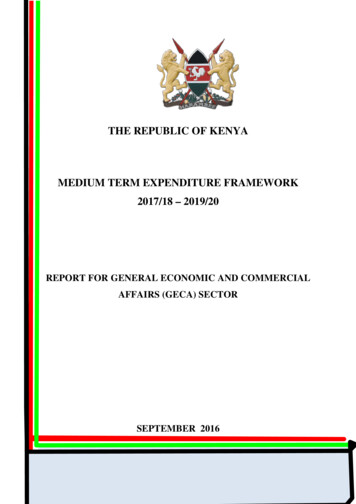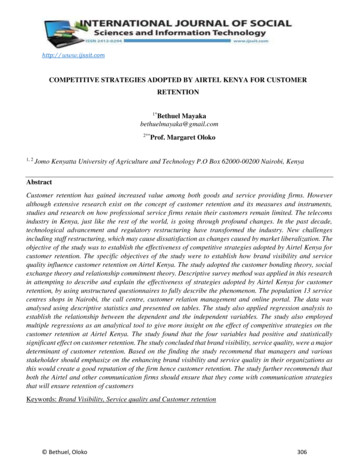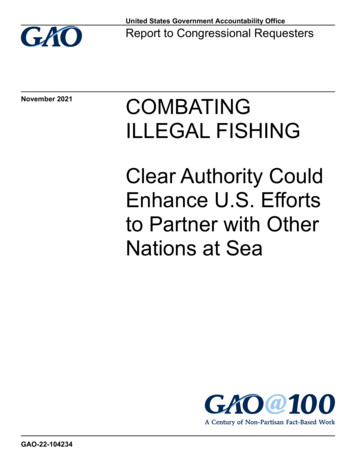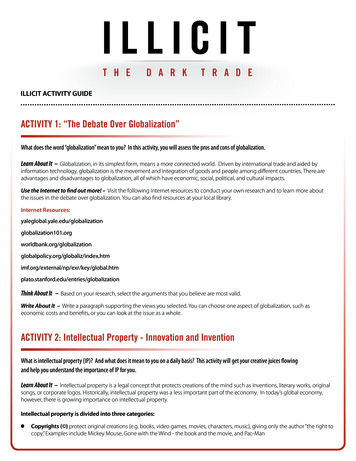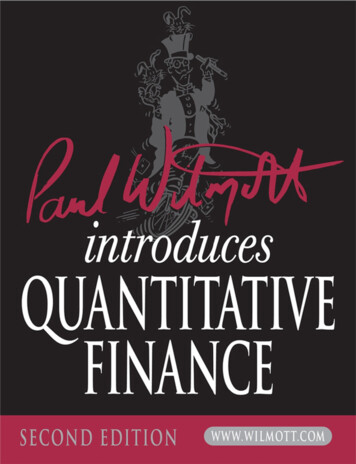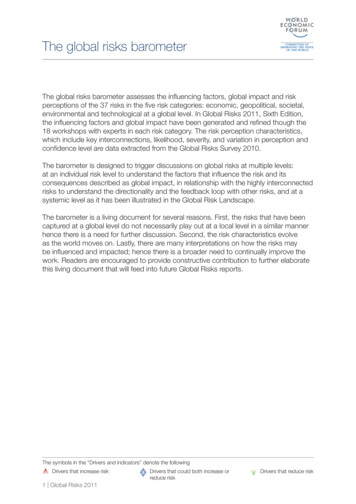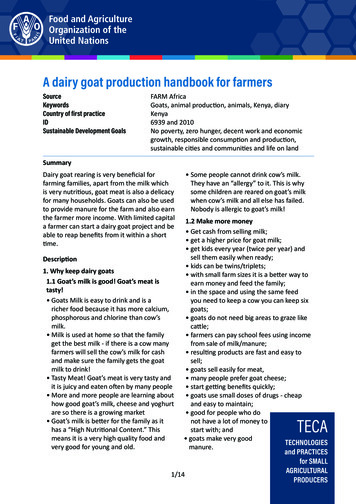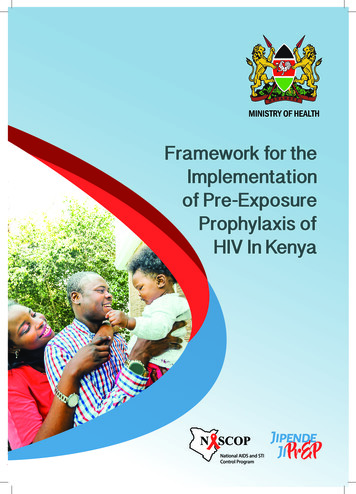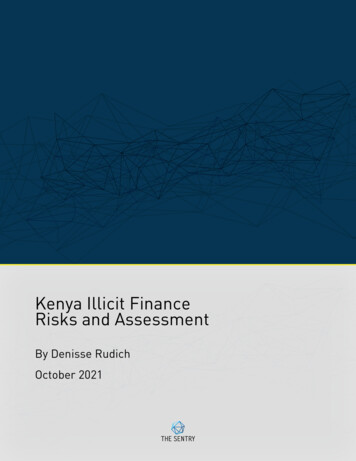
Transcription
Kenya Illicit FinanceRisks and AssessmentBy Denisse RudichOctober 2021
THE SENTRYTable of ContentsGlossary of Acronyms1Introduction3Key Findings3Regional Illicit Financial Flow Risks5Assessment of AML/CFT Framework14Recommendations27Appendix A: Risk Indicators32Appendix B: FATF 40 Recommendations35Endnotes37KENYA ILLICIT FINANCE RISKS AND ASSESSMENTTheSentry.org
THE SENTRYGlossary of PsESAAMLGEACCEUFATFFATF MLMERNCCTsNIFCNRANPOsPEPPOCAMLAPOTAAnti-money laundering and countering the financing of terrorismAsset Recovery AgencyAsset Recovery Inter-Agency Network for Eastern AfricaBusiness Registration ServiceCentral Bank of KenyaCustomer due diligenceCentral African RepublicCapital Markets AuthorityOffice of the Director of Public ProsecutionsDemocratic Republic of the CongoDesigned non-financial businesses and professionalsEastern and Southern Africa Anti-Money Laundering GroupEthics and Anti-Corruption CommissionEuropean UnionFinancial Action Task Force40 recommendations developed by the FATFUS Department of the Treasury’s Financial Crimes Enforcement NetworkFinancial intelligence unitsFinancial Reporting CentreFramework for the Return of Assets from Corruption and Crime in KenyaGross domestic productInternational Conference on the Great Lakes RegionInternational Monetary FundKenya Electronic Payment and Settlement SystemKenya Revenue AuthorityKnow your customerUnited Nations Multidimensional Integrated Stabilization Mission in the Central African RepublicMoney launderingMutual Evaluation ReviewNon-cooperative countries and territoriesNairobi International Financial CentreNational risk assessmentNonprofit organizationsPolitically exposed personThe Proceeds of Crime and Anti-Money Laundering Act, 2009Prevention of Terrorism Act, 2012KENYA ILLICIT FINANCE RISKS AND ASSESSMENTTheSentry.org1
THE PsVTDPNational Real Time Gross SettlementSuspicious Activity ReportsSudan People’s Liberation ArmySudan People’s Liberation Army in OppositionWorld Bank’s Stolen Asset Recovery InitiativeSuspicious transaction reportTerrorist financingUnited Arab EmiratesUnited KingdomUnited NationsUnited Nations Security CouncilUnited StatesVirtual assets service providersVoluntary Tax Disclosure ProgramKENYA ILLICIT FINANCE RISKS AND ASSESSMENTTheSentry.org2
THE SENTRYIntroductionKenya is a country that is rich in natural resources, has strong manufacturing and services sectors, and acts asa strategic gateway between East and Central Africa and Europe, the Middle East, and Asia. While this positionoffers great opportunity, it also makes Kenya highly susceptible to acting as a transshipment point for illicit tradeand finance, meaning that it is essential for Kenya to have effective and adequate anti-money laundering and countering the financing of terrorism (AML/CFT) measures in place. It is estimated that Kenya has lost more than 10.6billion in illicit financial flows since 1970, including via capital flight to banking secrecy havens of funds illegallyacquired by officials, individuals, and corporations.1 The US government recently listed Kenya as a “major moneylaundering jurisdiction,” citing numerous domestic and foreign criminal activities and highlighting that money laundering takes place in both the formal and informal sectors.2In the near future, Kenya is likely to undergo its Eastern and Southern Africa Anti-Money Laundering Group (ESAAMLG) mutual evaluation review (MER) and finalize a national risk assessment (NRA). Kenya’s AML/CFT systemis more advanced than others in the region. After having been through a MER in 2010, Kenya updated its AML/CFT framework, leading to its removal from the Financial Action Task Force’s (FATF) list of non-cooperative countries and territories (NCCTs) in just four years. The country is in the process of preparing for its next MER and hasalready tabled proposed updates to national AML/CFT laws and regulations.3 However, major risks remain.Since 2016, The Sentry has, through its investigative work in South Sudan and East and Central Africa, exposeda number of illicit financial activities in Kenya connected to regional corruption and conflict. The Sentry has historically emphasized the important role of the Kenyan financial system as a regional hub for South Sudanese elites tobank and purchase property, stating, “It’s vital that Kenyan banks and their regulators lead the way in implementing strict standards for anti-money laundering, anticorruption, and sanctions enforcement to protect the country’sfinancial system from abuse by the violent kleptocrats and corrupt elite in South Sudan who pump their ill-gottengains into Kenyan bank accounts and real estate holdings.”4 Kenyan authorities are beginning to take actionagainst foreign corruption, as evidenced by a recent asset-freezing action against a United States (US)-sanctionedSouth Sudanese official, although his account has subsequently been unfrozen.5, 6This report was compiled using open-source research and is set out in three sections. It focuses on areas that theESAAMLG assessment team should consider during its preparation for the onsite visit, as well as areas that thegovernment of Kenya may wish to assess as it finalizes its NRA and prepares for the MER. The first part of the report discusses illicit finance risks and typologies—many linked to South Sudan—to be considered and addressedas the government seeks to establish Kenya as a financial hub in Africa through its Vision 2030 and the development of the Nairobi International Financial Centre (NIFC). The second part of the report provides a high-level assessment of Kenya’s AML/CFT regime, informed by the FATF’s 40 Recommendations. The third section providesrecommendations to the MER team, the government of Kenya, and international partners, including an overviewof steps that Kenya should prioritize to protect the banking sector, the real estate sector, and other areas at risk ofabuse by illicit actors.Key Findings Weaknesses in Kenya’s finance and real estate sectors have been exploited to contribute to SouthSudan’s conflict. South Sudanese politically exposed persons (PEPs) responsible for the conflict haveKENYA ILLICIT FINANCE RISKS AND ASSESSMENTTheSentry.org3
THE SENTRYinfiltrated Kenyan banking, real estate, trade, defense, and corporate enterprises with their ill-gotten gains.Kenya is a destination country for illicit South Sudanese funds, which have been moved into Kenya usingKenyan corporate structures, luxury properties, and banks. Arms and munitions have also transited throughKenya into South Sudan. Kenya faces severe money laundering risks. Kenya faces numerous illicit finance risks that expose itssociety to crime and deprive it of public services. These risks include domestic corruption, terrorist financing, environmental crimes, illegal trafficking, tax evasion, and the misuse of digital finance such as mobilebanking and cryptocurrency. If Kenya has the political will, it has the ability to respond to existing threats, buttech-enabled and cyber risks require additional training and technology resources for an effective response. Kenya’s AML/CFT framework requires improvement. While Kenya has reasonably documented AML/CFTlaws and regulations, gaps remain around full documentation into law and effective implementation by boththe public and private sectors. Areas identified that require enhancement include the risk-based approach;proliferation financing; sanctions adherence; financial secrecy; resourcing available for AML/CFT compliance; PEPs; wire transfers and new technology; designated non-financial businesses and professionals(DNFBPs), particularly notaries and legal practitioners; public beneficial ownership registries; transparencyon the roles and responsibilities of competent authorities; and domestic barriers to international cooperation. Kenya’s AML/CFT efforts are more effective when linked to countering domestic corruption. Effectiveimplementation remains a challenge in several areas, and AML/CFT action by government and regulatorsseems to be more robust when linked to the domestic war on graft. This makes Kenya an attractive destination for corrupt foreign officials and their enablers to launder illicit financial flows from across Kenya’s borders.KENYA ILLICIT FINANCE RISKS AND ASSESSMENTTheSentry.org4
THE SENTRYRegional Illicit Financial Flow RisksThis section provides an overview of typologies used to hide and launder illicit proceeds from high-level politicalcorruption and criminality in East and Central Africa via Kenya. The MER team, the NRA team, and the Kenyangovernment should consider these risks as they identify higher AML/CFT risks and evaluate the effectiveness ofthe mitigating measures in place. This section also references Kenyan banks, corporations, and relationships identified in The Sentry’s reporting and considers key illicit finance risks such as terrorist financing, domestic corruption,environmental crimes, tax evasion, and exploitation of digital finance, which were identified through open-sourceresearch. A list of risk indicators is included in Appendix A.Foreign PEP involvementThe Sentry’s investigations have highlighted that several corrupt South Sudanese officials travel to and maintaintheir assets in Kenya.Real estate used to launder the proceeds of foreign corruptionThe Sentry has identified numerous cases in which South Sudanese PEPs have purchased luxury real estate inKenya for themselves or for their families. This could indicate that the sources of wealth and funds are not beingreviewed as part of due diligence checks by the Kenyan real estate sector. South Sudanese President Salva Kiirhas even acknowledged the trend, saying in 2016 that some government officials “have bought apartments, havebought very beautiful houses, villas. They are hiding it in Kenya and they refuse to reveal it.”7, 8One such individual is a South Sudanese general who is subject to US sanctions due to his involvement in massviolence against civilians.9 One source told The Sentry that the general’s family paid 1.5 million in cash for aproperty that is listed under the name of one of his wives.10 Another case identified a property belonging to a seniormilitary official who has been involved in violent land grabs, ethnic conflict, and corruption scandals.11 The Sentryfurther identified that family members of several of South Sudan’s highest-ranking PEPs reside in one particularupscale neighborhood in Nairobi and their children attend local private schools.12 In yet another instance, TheSentry found that a South Sudanese PEP involved in mining owned a luxury house in Nairobi, the value of whichsignificantly exceeded his modest salary.13Joint corporate shareholdings with Kenyan PEPs to move dirty fundsThe Sentry has identified several examples in which Kenyan citizens, including members of the political elite andtheir families, have set up businesses with corrupt foreign PEPs, making it easier to move illicit funds around theregion. This supports the case for beneficial ownership transparency of corporate structures.In one instance, a Kenyan PEP was identified as having a partial stake in a South Sudan registered company thathad entered into a joint venture with a company owned by family members of a South Sudanese PEP. The newcompany, created as part of the joint venture as a “special purpose vehicle,” is described as engaging “in the provision of services in the oil sector,” including waste management, drilling, logistics, and air transportation. However,it more likely personally benefited family members of the South Sudanese PEP.14Another company, which appears to be jointly owned by a Kenyan citizen and South Sudanese PEPs, based onthe signatures in corporate documents, was used to transfer US dollars into a South Sudanese PEP’s personalKENYA ILLICIT FINANCE RISKS AND ASSESSMENTTheSentry.org5
THE SENTRYaccount held at a Kenyan bank.15 The South Sudanese PEP was identified by the United Nations (UN) as beingresponsible for the violence that led to famine in South Sudan.16,17A final example includes a company that operates in the oil industry in South Sudan and is owned by the son of ahigh-ranking South Sudanese PEP, with the remaining shares held by three Kenyan businessmen.18Misuse of corporate structures for illicit tradeThe Sentry has also found that foreign PEPs have used Kenyan corporate structures to siphon funds from theirhome countries. In one example, a Kenyan oil company was used to funnel payments to the personal account of aSouth Sudanese general who acted as a commander during a military offensive—one that led to the displacementof 100,000 people in South Sudan—and who is subject to UN sanctions. The funds were purported to be “a refundto the SPLA [Sudan People’s Liberation Army]” for failing to deliver fuel, but they do not appear to have made it tothe South Sudanese Treasury.19A separate incident involved the use of Kenyan corporate structures and Kenyan banks to transfer funds to anAustralia registered company owned by a family member of a different South Sudanese general. The family member subsequently purchased luxury real estate and luxury vehicles in Australia, which were frozen and seized byAustralian authorities.20Some Kenyan corporate structures were beneficiaries of the 922 million South Sudanese letters of credit scandal,in which oil-backed loans were used to secure financing to import food and goods from neighboring countries.These corporate structures, which were owned by South Sudanese senior officials, members of their families, orwell-connected traders, failed to provide the goods following payment, contributing to widespread severe hungerand famine in South Sudan.21Kenyan corporate structures have also been misused by a UN-sanctioned warlord from the Central Africa Republic(CAR). This individual, who allegedly has ties with Kenyan politicians, traveled to Kenya in 2014 prior to beingsanctioned in 2017 by the UN for “engaging in or providing support for acts that undermine the peace, stability orsecurity of the CAR, including acts that threaten or impede the political transition process, or the stabilization andreconciliation process or that fuel violence” and for being “involved in planning, directing, sponsoring, or conductingattacks against UN missions or international security presences, including MINUSCA [the UN MultidimensionalIntegrated Stabilization Mission in the Central African Republic], the European Union Missions and French operations which support them.”22 Between 2014 and 2016, he used a network of companies to develop an illicit trade indiamonds and gold, and in exchange he was supposed to receive military equipment, weapons, and ammunitionvia the Democratic Republic of Congo (DRC) or Sudan.23These examples further highlight the need for beneficial ownership transparency and for firms subject to AML/CFTmeasures to monitor and report suspicious transactions.Bank accounts used for cross-border illicit transfersThe Sentry has obtained documents indicating that millions of dollars in questionable payments linked to top SouthSudanese officials have transited through Kenyan banks, reinforcing the need to monitor and report suspicioustransactions and to have foreign PEP due diligence measures in place.24 In one instance, a South Sudanese PEPpurchased a luxury home using a US dollar-denominated account held at the Ugandan branch of a Kenyan bank.KENYA ILLICIT FINANCE RISKS AND ASSESSMENTTheSentry.org6
THE SENTRYThis occurred during a period of intense fighting involving a nonstate militia that was funded and supported by thePEP’s office.25In a separate example, a Kenyan bank housed a South Sudanese PEP’s US dollar-denominated personal account, through which millions transited.26 Transactions included the receipt of large cash deposits and paymentsfrom construction companies backed by Chinese, Lebanese, and possibly Turkish investors and the withdrawal ofover 1 million in cash by the South Sudanese PEP. In a case involving another South Sudanese PEP, suspicioustransactions were related to “reimbursement” payments for a fuel supply deal that fell through and took the formof transfers of hundreds of thousands of dollars into the PEP’s account by a multinational corporation operating inSouth Sudan.27In another matter, bank records reviewed by The Sentry indicate that a Kenyan bank processed payments for thepersonal account of a UN-sanctioned South Sudanese PEP. The account received suspicious financial transfers,including from someone who shares a name with the advisor of a high-ranking Kenyan PEP and from a Kenyanmultinational petroleum company operating in South Sudan. The account continued to operate after UN sanctions were imposed.28 Kenyan corporate structures have also been used to siphon government funds from SouthSudan and facilitate arms transfers.29, 30 Recently, Kenyan authorities froze an account held at a Kenyan bank bya US-sanctioned South Sudanese minister.31 A Kenyan court has since lifted the account freeze order, having accepted the minister’s explanation that the funds in the account were the proceeds of his salary and rental income.32The account held 13.42 million Kenyan shillings (approximately 124,260), but the minister had previously held aUS dollar-denominated account through which an estimated 460,896.20 was transferred prior to its being closedin 2019.33Financial sector growth in risky marketsIn recent years, Kenya has emerged as a regional banking hub connecting East and Central Africa to internationalfinancial centers such as London, New York, and the United Arab Emirates (UAE). Several Kenyan banks havebranches overseas and correspondent banking relationships with top-tier financial institutions around the world.Kenya’s second-largest bank, Equity Group, is now the largest bank in the DRC, will likely be the second-largestbank in Rwanda and possibly the third-largest bank in Uganda, and has a license to operate in Ethiopia.34 KCB,Kenya’s largest bank, has foreign subsidiaries in South Sudan, Uganda, Rwanda, Burundi, and Tanzania.35 NCBABank Kenya, Kenya’s third-largest bank, is partially owned by President Uhuru Kenyatta’s family and has operations in Rwanda, Kenya, Tanzania, Uganda, and the Ivory Coast.36 There are indications that it was previouslyseeking to expand into Burundi and South Sudan.37, 38 Kenya’s banking presence in these regions is a positivestep toward financial inclusion in these countries, but enhanced due diligence is key to managing correspondentbanking relationships while at the same avoiding large-scale de-risking action.The Sentry’s reporting has identified Kenya as the largest foreign investor in the South Sudanese banking sector.South Sudan significantly relied upon Kenya for financial services during the war, and this close relationship hascontinued, with Kenya acting as a significant food export partner to South Sudan. Today, some South SudanesePEP-owned or -controlled banks have Kenyan investors, and South Sudanese banks with correspondent relationships with Kenyan banks may hold nested accounts in Kenya. Additionally, most remittances sent to South Sudanfrom around the world are spent in Kenya and Uganda.39The Sentry has also reported numerous questionable transactions involving top officials from South Sudan andbanks in Kenya. A previously undisclosed internal audit of South Sudan’s central bank describes significant irregKENYA ILLICIT FINANCE RISKS AND ASSESSMENTTheSentry.org7
THE SENTRYularities pertaining to South Sudanese state assets deposited into Kenyan banks.40, 41The US government has found that some financial institutions in Kenya are involved in currency transactions thatare linked to international narcotics trafficking.42Local mines covering for conflict gold smugglingFollowing an in-depth investigation, The Sentry raised serious concerns that a corporate network had purchasedconflict gold from the DRC, processed it in Uganda, and exported it to the UAE. Companies in this network claimedto have sourced gold from accredited mines in Kenya.43 Kenya’s Vision 2030 blueprint includes plans “to havea certification laboratory and audit agency” for minerals.44 The Ministry of Petroleum and Mining indicated thatit would equip and operationalize the Mineral Certification Laboratory and establish four mineral audit offices byMarch 31, 2019.45 No further updates are available to confirm that a certification laboratory or audit agency officeshave been established or to indicate that Kenya has implemented mine certification as part of the InternationalConference on the Great Lakes Region (ICGLR) minerals certification process.Arms and munitions shipments to regional conflict zonesThe financing for arms and munitions contracts should be subject to enhanced due diligence, and firms shouldidentify beneficial owners for legal structures. However, The Sentry’s reporting has identified Kenya as a transshipment site for arms and munitions intended for use in South Sudan.46 In one case, armored vehicles and spareparts were delivered in several shipments to a site in Kenya. The shipment was sent by a Russian company onbehalf of a company based in the UAE, reportedly South Sudanese owned.47 South Sudan’s Ministry of Interiorsubsequently received the vehicles, which have been photographed on the battlefield as recently as 2018.48 In aseparate case, an American arms trafficker attempted to sell a trove of weapons worth 43 million to an oustedSouth Sudanese warlord. Initially, the weapons were to be sold to a Kenya-based shell company linked to theSouth Sudanese warlord, who owns a mansion with his family in Kenya worth approximately 2 million.49A report by Conflict Armament Research on the supply of weapons into South Sudan during the civil war identifiedfurther links with Kenya. In May 2014, a Chinese arms manufacturer sent tens of thousands of arms and munitions,including small caliber ammunition, rockets, grenades, grenade launchers, assault rifles, pistols, and machineguns, to Juba via Kenya. The UN arms embargo did not come into effect until July 2018; thus, the transfers likelydid not violate international law at the time. As of 2017, around 56% of ammunition sampled by Conflict ArmamentResearch in South Sudan included a code denoting that it was manufactured by a state factory in China.50 In 2015,an official from the Sudan People’s Liberation Army in Opposition (SPLA-IO) entered into negotiations for US individuals to supply and operate large civilian aircraft—used to move military personnel and equipment—via US andKenyan companies. The deal was not finalized, and it is not clear whether US counterparts were cognizant thatthey had entered into negotiations with the opposition.51 SPLA-IO officials also tried to acquire their own aircraft,entering into negotiations with a US lawyer and a Somali-US citizen to buy a second-hand aircraft for 4 million inlate 2015 and early 2016. The seller was listed as a newly registered Kenyan subsidiary of a US company.52Additional illicit finance risksTerrorist financing to support local attacksIn recent years, Al-Qaeda Somali affiliate group Al-Shabaab has been raising funds and committing acts of terrorKENYA ILLICIT FINANCE RISKS AND ASSESSMENTTheSentry.org8
THE SENTRYism in Kenya.53 In 2013, militants launched an attack at Westgate Mall that resulted in the death of 67 people afteran 80-hour siege.54 In 2015, 147 students were killed at a shooting at Garissa University.55 And in January 2019,21 people were killed when Al-Shabaab militants stormed a luxury hotel in Nairobi.56Terrorist financing in Kenya has been linked to corruption and mobile banking. Hawala networks, which have beenlinked to terrorist financing, and unlicensed remittance systems enable unregistered cash-based money flows.57Key controls to manage terrorist financing risk include sharing financial intelligence, including originator and beneficiary information on payments; placing loading limits and geographical transfer limits; recording available metadatafrom mobiles; and screening against domestic terrorist lists. However, these mitigants are not effective againstcash-based transactions. A recent study found that some Kenyan officers fighting Al-Shabaab in Somalia haveinstead helped the group smuggle sugar over the border into Kenya.58 It is estimated that approximately 150,00tons of sugar are smuggled into Kenya each year and that the trade is worth between 200 million and 400 million.59 Members of the Kenyan military are alleged to be assisting Al-Shabaab in charcoal smuggling, as well. It isestimated that charcoal worth more than 140 million shillings ( 1.3 million) is smuggled out of Kenya monthly.60, 61Kenyan court documents filed by the Anti-Terrorism Police Unit following the 2019 hotel attack identified mobilemoney transfers to terror suspects, including from South Africa, via 47 SIM cards.62 Al-Shabaab, which releaseda public statement in January 2020 that “Kenya Must Take Heed,”63 is also known to raise funds through diasporaremittances, charcoal trade-based money laundering, taxes, and checkpoint fees.64 More financial intelligencesharing is needed to address the threat of terrorist financing.A potential weakness in Kenya’s regulation includes an amendment to the Finance Act 2018, which created aloophole that may be vulnerable to exploitation to finance terrorism. Clause 38 amended section 37B(4) of the TaxProcedures Act 2015, effectively extending the period of a tax amnesty—which was issued to encourage the returnof funds held overseas—by one year.65 Information about the tax amnesty indicates that funds transferred would beexempt from provisions of The Proceeds of Crime and Anti-Money Laundering Act, 2009 (POCAMLA) “or any otherAct relating to reporting and investigation of financial transactions, to the extent of the source of the funds excludingfunds derived from proceeds of terrorism, poaching and drug trafficking.”66 Tax Justice Africa argued that this loophole “weakens current financial reporting, investigations and surveillance mechanisms carried out by the FinancialReporting Centre” and could have been used to repatriate funds linked to terrorism and crime, creating a gatewayfor terrorist financing into Kenya.67 The Finance Act 2020 subsequently introduced a Voluntary Tax Disclosure Program (VTDP) from January 2021 to December 2023 “to give opportunity to taxpayers who have undisclosed taxliabilities to disclose the same to the Kenya Revenue Authority (KRA) without facing any legal consequences suchas prosecution.”68, 69 This new program may also be susceptible to being abused for criminal activity.Mixed implementation leads to sanctions violationsCorporate structures and financial institutions operating in Kenya may be at risk of facilitating breaches of UNcountry sanctions. Kenya does not appear to have a body responsible for regulating, issuing guidance, enforcing,or monitoring compliance with UN sanctions programs (country programs) that fall outside Kenyan legislation covering terrorist financing or proliferation financing sanctions.70, 71, 72 Article 2(6) of the Constitution of Kenya allows forany ratified treaty or convention to become part of the laws of Kenya, and because Kenya is a signatory of the UNCharter, this could include UN sanctions.73 Only the High Court of Kenya can determine whether a certain “omission or violation has occurred and that the same amounts to a breach of law” and “a breach of the UN Charter.”74This makes the application of UN sanctions programs related to non-terrorist or proliferation financing, such as theSouth Sudan program, uneven across the country and among differing industries. For example, there are individKENYA ILLICIT FINANCE RISKS AND ASSESSMENTTheSentry.org9
THE SENTRYuals who are subject to UN travel bans under the South Sudan sanctions program who regularly visit Kenya.75 Inorder for Kenya to live up to its UN obligations, further action is required.With regard to extraterritorial sanctions, the US, the United Kingdom (UK), and the European Union (EU)—amongothers—have sanctioned Kenyan nationals linked to terrorism, corruption, or conflict.76, 77, 78, 79 These sanctionshave been portrayed by some in Kenya as being “politically motivated and designed to preserve geopolitical orbusiness advantage.”80Laundering the proceeds of domestic corruptionDomestic corruption in Kenya is rife, but enhanced due diligence on PEPs can help prevent the laundering of theproceeds of corruption. In 2015, Kenyatta branded corruption a threat to national security and renewed the war ongraft.81 One year later, Kenya’s anti-graft chief stated that the country was losing a third of its state budget—around 6 billion—to corruption.82 A 2017 survey by Kenya’s Ethics and Anti-Corruption Commission (EACC) found that“corruption and unethical conduct permeate all sectors both public and private.”83 In early 2021, Kenyatta was quoted stating, “The amount they [public officials] steal every day is more than Sh2 billion.“84 The use of offshore bankaccounts in secrecy jurisdictions is widespread, and numerous Kenyan PEPs were exposed hiding their wealthoffshore by the Panama Papers.85, 86Corruption is often cited by businesses abroad as a barrier to investment,87 and corrupt practices range from themost prevalent form—which involves payment of bribes for government services, particularly when registering orseeking identity records—to abuse of office, favoritism, and delays in service provision, among others.88 The UNhas also linked corruption by individuals involved in law enforcement operations—the police, military, and customs—to the illicit wildlife trade.89A recent probe has been opened into the allocation of contracts linked to the country
Kenya faces severe money laundering risks. Kenya faces numerous illicit finance risks that expose its society to crime and deprive it of public services. These risks include domestic corruption, terrorist financ-ing, environmental crimes, illegal trafficking, tax evasion, and the
